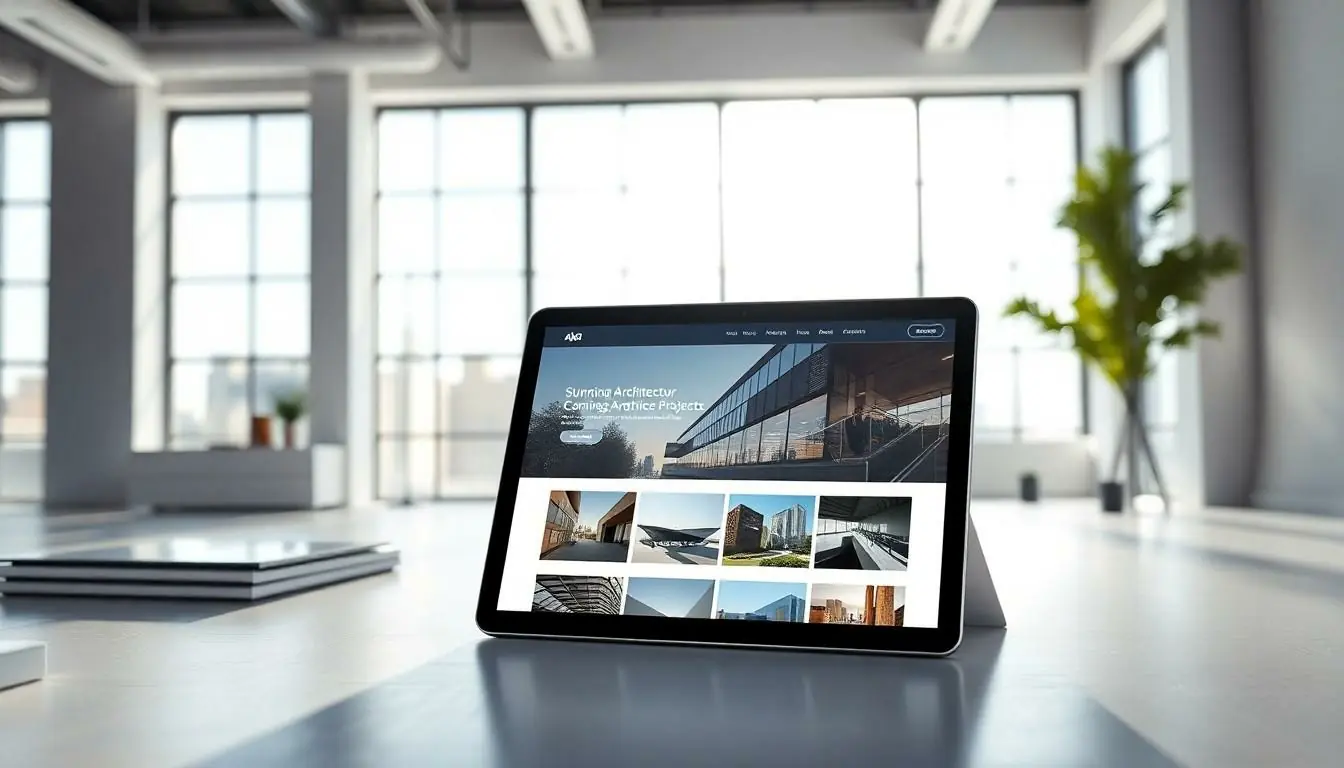Table of Contents
ToggleIn a world where first impressions are everything, an architecture website can make or break a potential client’s interest. Picture this: a stunning building with a lackluster online presence. It’s like a Michelin-star chef serving up instant noodles—just doesn’t add up! A well-designed website is the digital equivalent of a grand entrance, setting the stage for creativity and professionalism.
Importance of Architecture Website Design
A well-designed architecture website is essential for attracting potential clients. First impressions matter in the digital age, and a strong online presence reflects professionalism. Visual appeal plays a significant role in showcasing creativity, much like a striking building does in real life. Poor website design can diminish credibility, analogous to a Michelin-star chef serving instant noodles.
User experience is critical for retaining visitors. Intuitive navigation encourages exploration, enabling clients to find necessary information easily. Design elements such as color schemes, typography, and layout contribute to brand identity, reinforcing a firm’s unique style. Engaging content, including high-quality images and project descriptions, demonstrates a firm’s expertise and portfolio.
Search engine optimization factors into website effectiveness. Incorporating relevant keywords can improve visibility, making it easier for potential clients to find a firm. Responsive design ensures that a website functions well across devices, catering to users on desktops, tablets, and smartphones. Mobile optimization is crucial, as a significant percentage of users browse on mobile devices.
Showcasing testimonials enhances trust. Client reviews and project success stories build credibility and encourage potential clients to reach out. Social media integration aids in promoting content and engaging with a broader audience. Effective architecture website design combines aesthetics and functionality, creating an inviting digital space that captures interest and fosters connections.
Key Elements of Effective Architecture Websites

Effective architecture websites rely on various critical elements that enhance both appearance and functionality. A combination of visual appeal and user experience captivates visitors while presenting a firm’s work and values.
Visual Aesthetics
Visual aesthetics play a vital role in attracting potential clients. An appealing color scheme reinforces brand identity and sets the mood for the website. High-quality images exhibit previous projects, showcasing talent and attention to detail. Typography contributes significantly to the overall look, making text legible and aligning with the firm’s style. Consistency in design elements, from headers to buttons, maintains a cohesive feel throughout the site. Integrating white space enhances readability and emphasizes important content, ensuring that the website remains clean and professional.
User Experience
User experience directly affects how visitors interact with an architecture website. Intuitive navigation simplifies the exploration of projects and services, allowing users to find relevant information quickly. Fast loading times contribute to a seamless experience, preventing frustration from delays. Mobile optimization ensures accessibility across various devices, accommodating the growing number of users browsing on smartphones and tablets. Engaging content, such as project descriptions and case studies, keeps visitors interested and encourages them to explore further. Overall, prioritizing user experience establishes a strong connection with potential clients and enhances retention rates.
Best Practices for Architecture Website Design
Creating an effective architecture website involves prioritizing mobile responsiveness and SEO optimization. These elements enhance user experience and boost visibility.
Mobile Responsiveness
Mobile responsiveness ensures functionality on various devices. Websites must automatically adjust to different screen sizes, from desktops to smartphones. Given that 54.8% of web traffic comes from mobile devices, this capability is essential. Navigation should remain intuitive, regardless of device type. Additionally, fast loading times contribute to user satisfaction. Optimizing images and minimizing heavy scripts helps maintain speed. Implementing a responsive design leads to better engagement, resulting in longer visits. A seamless mobile experience builds trust with potential clients, reflecting professionalism.
SEO Optimization
SEO optimization increases a website’s visibility in search engine results. Integrating relevant keywords throughout the site enhances discoverability. Using descriptive alt text for images improves accessibility and boosts rankings. High-quality content engages users, fostering exploration of services and projects. Meta descriptions and title tags should be meticulously crafted for maximum impact. Focusing on local SEO strategies, such as including location-based keywords, attracts nearby clients. Additionally, implementing an efficient site structure aids navigation and search indexing, making it easier for users to find essential information. Prioritizing these SEO practices contributes significantly to website success.
Tools and Platforms for Building Architecture Websites
Numerous tools and platforms facilitate the creation of architecture websites. WordPress ranks as a leading option, boasting a wide selection of themes and plugins tailored for design professionals. Squarespace offers an intuitive interface paired with beautifully crafted templates, allowing for quick setup and customization.
Wix includes drag-and-drop features that cater to users with varying technical expertise, making it easy to build visually appealing sites. Webflow permits advanced design capabilities while maintaining user-friendly functionalities, appealing to designers seeking more control over layout and animations.
Figma, a collaborative design tool, enables teams to create prototypes and mockups, fostering effective communication among members during the design process. Adobe XD supports similar functionality, allowing designers to develop user experiences efficiently.
For image optimization, tools like TinyPNG compress images without sacrificing quality. High-resolution images contribute to a stunning presentation, ensuring architecture firms capture client attention effectively. Google Analytics provides insights into website performance, helping firms refine their strategies and improve user engagement.
SEO tools, such as Yoast SEO, assist in optimizing content for better search engine visibility, ensuring target clients can discover architecture websites. Keyword planners help identify relevant terms to incorporate, enhancing online searchability.
Finally, integrating social media platforms boosts engagement, allowing architecture firms to promote their work more dynamically. Overall, these tools and platforms equip designers with the resources needed to build impactful, user-friendly architecture websites.
A well-crafted architecture website is more than just a digital portfolio; it’s a vital tool for attracting and engaging clients. By seamlessly blending aesthetics with functionality, firms can create a memorable online presence that reflects their unique identity. Prioritizing user experience through intuitive navigation and mobile optimization ensures visitors stay engaged and explore further.
Incorporating effective SEO strategies enhances visibility, making it easier for potential clients to discover the firm. Utilizing the right tools and platforms streamlines the design process, allowing architects to showcase their work beautifully. Ultimately, a thoughtfully designed website not only showcases talent but also builds trust and fosters lasting connections in the competitive architecture industry.







